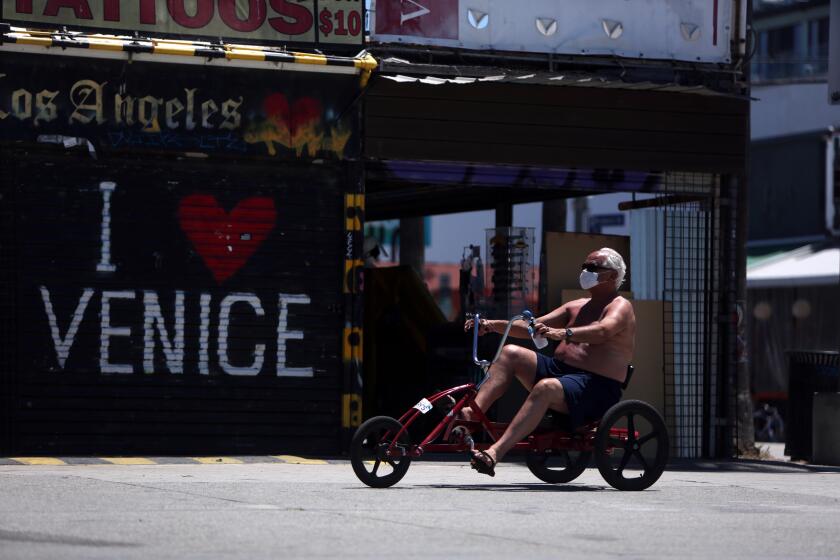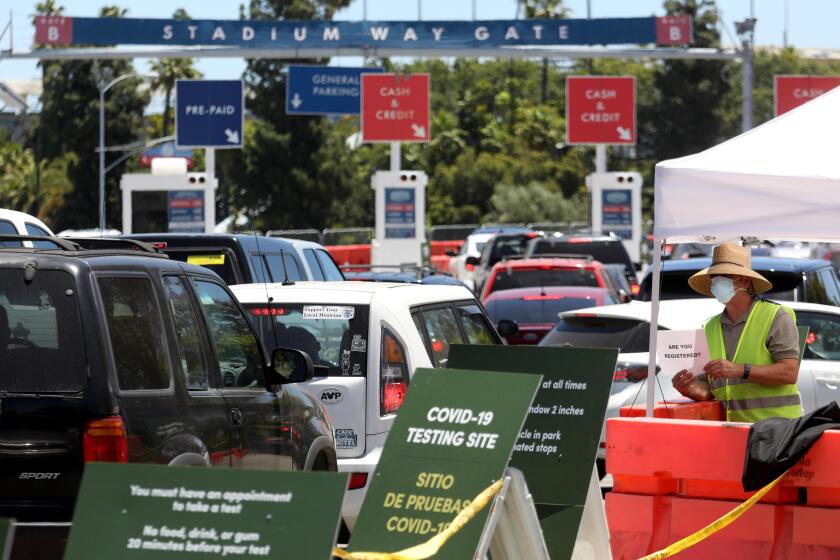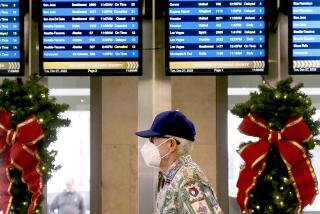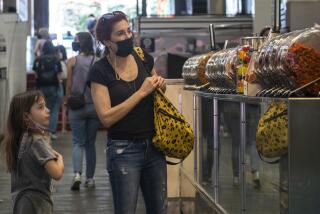L.A. faces critical coronavirus test: Will reopening more businesses bring serious new outbreaks?
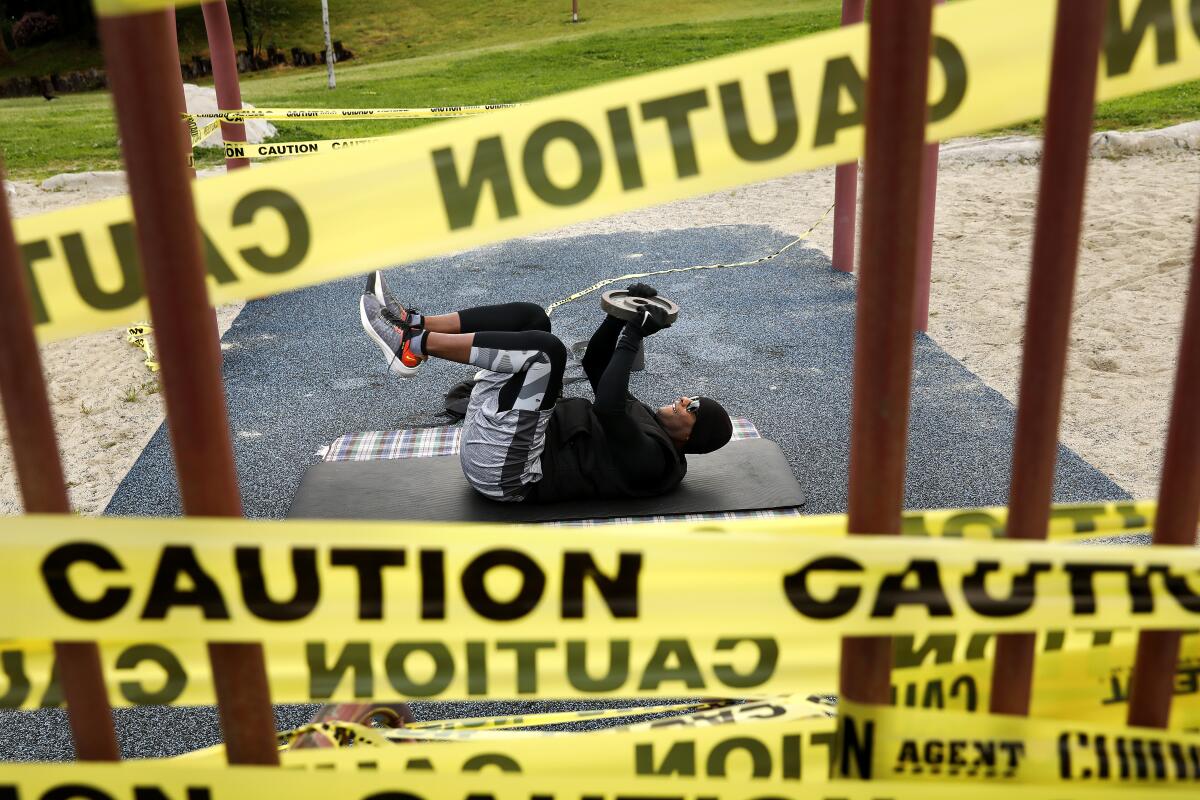
- Share via
Los Angeles County is facing a critical new test in its battle against the coronavirus.
Officials are taking another major step in reopening the economy as a slew of additional businesses get the green light to begin accepting customers — and anxious health officials wait to see how much these new activities worsen the spread of the highly contagious virus.
On Friday, L.A. County will allow the reopening of gyms; venues such as museums, zoos and aquariums; campgrounds; and hotels for leisure travel. It will also greenlight the resumption of music, film and TV productions.
The reopening comes as the virus’s toll continues to grow. Officials Thursday reported 50 more deaths and an additional 1,848 cases of the virus. The county’s total infections are more than 68,000, almost half of the state’s case count of more than 143,000. The cumulative death toll in L.A. County — 2,818 — represents 57% of the state’s death toll of more than 4,900, despite the county being home to one-quarter of the state’s population.
Officials always expected an increase in the number of coronavirus cases as the strictest version of the stay-at-home order was gradually weakened.
The question now is whether the virus will cause the hospitalizations of a moderate number of people that the hospital system can handle, or if it will grow into a surge of severely ill patients, overwhelming intensive-care units.
It’s too soon to say what will happen. Here’s a rundown on bits of the bad news and some good news in terms of where L.A. County stands.
Virus transmission rate is rising
There is even more evidence that the spread of the novel coronavirus is rising, according to data released this week.
Before the county began easing stay-at-home requirements last month, the effective transmission rate of the coronavirus was in a good spot: For every one person infected, that person on average infected less than one other person, said Dr. Christina Ghaly, L.A. County’s director of health services.
But on Friday, Ghaly disclosed publicly for the first time that the transmission rate is now greater than 1.
Then, on Wednesday, Ghaly said county scientists are now more certain the transmission rate is indeed increasing.
The county published a chart showing how the effective transmission rate, which was below 1 in April, began ticking upward, rising above 1 by the last week in May. That means every one person infected with the virus was, by that point, infecting more than one other person, on average.
That increase occurred about two weeks after Mother’s Day, and a little more than two weeks after L.A. County allowed many retail stores to open for pickup service.
“The model predicts more firmly that the spread of COVID-19 in the Los Angeles County area is likely to increase gradually over time,” Ghaly said Wednesday.
As a result, the computer model used by L.A. County to estimate future demand on hospitals predicts there will be heavier use by coronavirus patients in the next two to four weeks, Ghaly said. Still, there should be sufficient hospital beds and ventilators to accommodate the increased demand, she said.
L.A. County could run short of ICU beds
But it’s possible the county’s public and private hospitals could run out of ICU beds in the next two to four weeks, Ghaly said.

At the same time, county health officials have defended their reopening plan. Authorities are still asking people to stay home as much as possible, but “there are good reasons why sometimes people need to or want to leave their home,” Ghaly said.
“Some people don’t have the privilege of being able to telework, and they have to leave their home to work. Many people wish to lend their voice in the fight for justice that is going on around all of us,” she said. “The key to controlling the virus does not have to mean remaining at home.”
There is a chance that the nation’s most populous county could run out of intensive care unit beds in two to four weeks, officials said Wednesday.
Business reopenings continue
Businesses allowed to reopen Friday include gyms and fitness facilities, pro-league arenas without audiences, day camps, museums, galleries, zoos, aquariums, campgrounds, outdoor recreational areas and hotels for leisure travel. There are limits on capacity, stringent cleaning requirements and a mandate that staff wear face coverings at all times.
Additionally, anyone visiting such facilities is advised to practice social distancing and to wear face masks. The U.S. Centers for Disease Control and Prevention has noted, however, that anyone with a breathing problem and children under 2 should not wear face coverings.
At gyms and fitness facilities, employees and customers will be screened for symptoms before entering. Reservations are encouraged because occupancy will be limited, and group training classes will also be limited in size.
Pools will be allowed to reopen, but saunas, steam rooms and hot tubs will remain closed. Visitors are required to wear face coverings while entering and exiting the gym and are advised to wear them while exercising.
At day camps, employees and staffers will be screened for symptoms via temperature check, and campers are advised to bring their own meals.
Capacity will be limited at museums, galleries, zoos and aquariums, though it is unclear to what degree. Interactive exhibits will remain closed, and tours can include only members of the same household. Officials have not permitted gatherings or the mixing of households, because the virus continues to pose danger.
The only exceptions to the ban on gatherings are political protests and religious services, although there are limits to the number of people who are allowed to attend those gatherings as well.
The bulk of California’s cases are still in Los Angeles County, where officials reported 61 additional COVID-19-related deaths and 1,275 new cases on Wednesday.
Visitors to campgrounds, RV parks and outdoor recreation areas are advised to make reservations and to obtain any needed permits online or by phone before their visit.
Staff working in professional sports areas will be required to wear masks and will be screened for symptoms before work. Athletes will be required to wear masks at all times, except while exercising, and broadcasters should expect different camera placements that allow for physical distancing.
At hotels and short-term rentals, guests will be screened for symptoms and will not be allowed to stay overnight if showing signs of illness. Reusable materials in rooms, including magazines and menus, will be removed, and rooms will be left vacant for 24 to 72 hours following a guest’s departure.
“In the event of a presumptive case of COVID-19, the guest’s room will be removed from service and quarantined. In the event of a positive case, the room should only be returned to service after undergoing a deep cleaning in accordance with [CDC] guidelines,” the county wrote.
Saunas, steam rooms and hot tubs at rental properties and hotels will remain closed.
More to Read
Sign up for Essential California
The most important California stories and recommendations in your inbox every morning.
You may occasionally receive promotional content from the Los Angeles Times.
